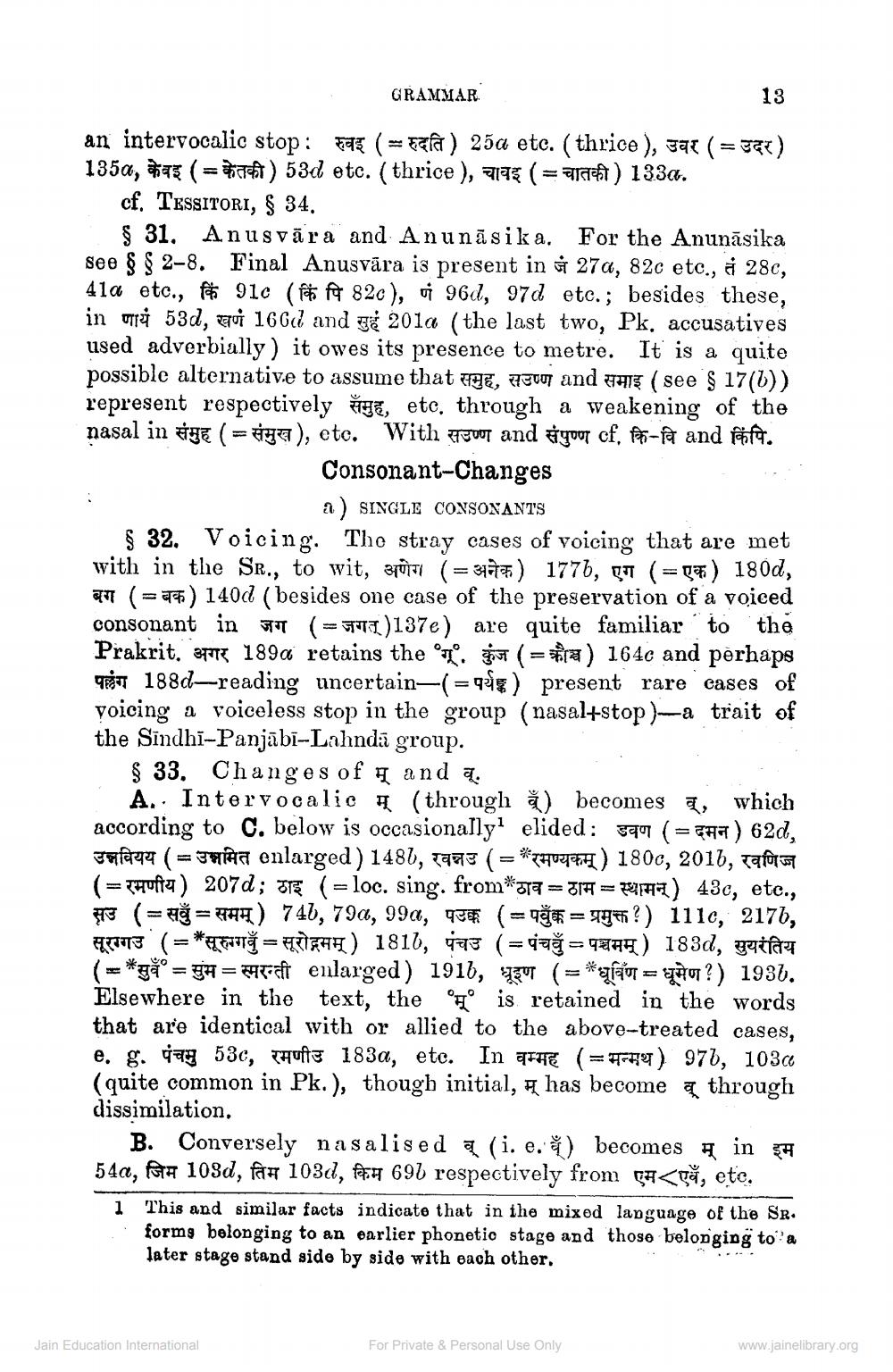________________
GRAMMAR
an intervocalic stop : रुवइ ( रुदति ) 25a etc. ( thrice ), उवर ( = उदर ) 1350, केवइ ( = केतकी) 53d etc. ( thrice ), चावइ ( = चातकी) 1330.
cf. TESSITORI, § 34.
§ 31. Anusvära and Anunasika. For the Anunāsika see §§ 2-8. Final Anusvära is present in 27a, 82c etc., 28c, 41a etc., f 91c (ff 82c), i 96d, 97d etc.; besides these, in 53d, i 166d and 201a (the last two, Pk, accusatives used adverbially) it owes its presence to metre. It is a quite possible alternative to assume that समुह, सउण्ण and समाइ ( see $ 17 (b)) represent respectively, etc. through a weakening of the nasal in संमुह (= संमुख ), etc. With उण्ण and संपुण्ण cf, कि-वि and किंपि . Consonant-Changes
13
a) SINGLE CONSONANTS
$ 32. Voicing. The stray cases of voicing that are met with in the SR., to wit, अणेग ( = अनेक ) 1776, एग ( = एक ) 180d, बग (= बक) 140d (besides one case of the preservation of a voiced consonant in (=)137e) are quite familiar to the Prakrit. 189a retains the . (a) 164c and perhaps 188d-reading uncertain-(-) present rare cases of voicing a voiceless stop in the group (nasal+stop)-a trait of the Sindhi-Panjabi-Lahnda group.
§ 33. Changes of and a A. Intervocalic (through ) becomes, which according to C. below is occasionally1 elided: (=) 628, उन्नवियय ( = उन्नमित enlarged ) 1487, रवन्नड ( = *रमण्यकम् ) 180c, 2016, रवणिज (=ft) 207d; (loc. sing. from*==) 43c, etc., सउ (= सकुँ = समम् ) 746, 79, 99a, परक्क ( = पयुँक्क = प्रमुक्त ? ) 111c, 2176, सूरग्गड ( = * सूरुग्गबुँ = सूरोद्गमम् ) 1816, पंचउ (= पंचवुं पञ्चमम् ) 183d, सुयरंतिय ( = *सुवँ° = सुंम = स्मरन्ती enlarged ) 1916, धूइण (= * धूर्विण = धूमेण ? ) 1936. Elsewhere in the text, the is retained in the words that are identical with or allied to the above-treated cases, eg. पंचमु 53e, रमणीउ 183a, etc. In वम्मह ( = मन्मथ ) 976, 103 (quite common in Pk.), though initial, has become a through dissimilation. in इम
B. Conversely nasalised (i. e.) becomes म् 540, जिम 108d, तिम 103d, किम 696 respectively from एम < एवँ, etc.
1
Jain Education International
This and similar facts indicate that in the mixed language of the SR. forms belonging to an earlier phonetic stage and those belonging to a later stage stand side by side with each other.
For Private & Personal Use Only
www.jainelibrary.org




